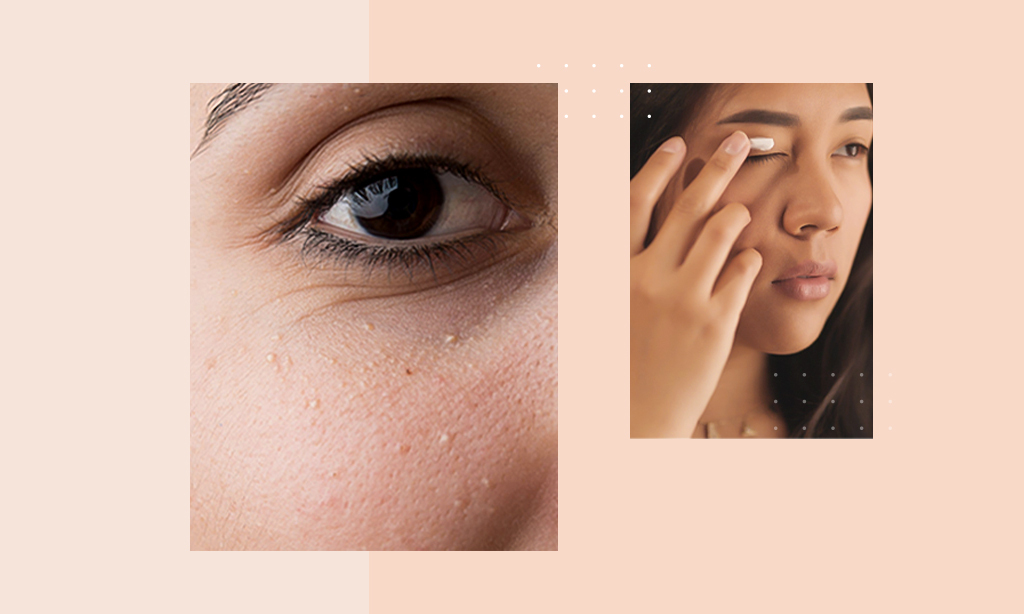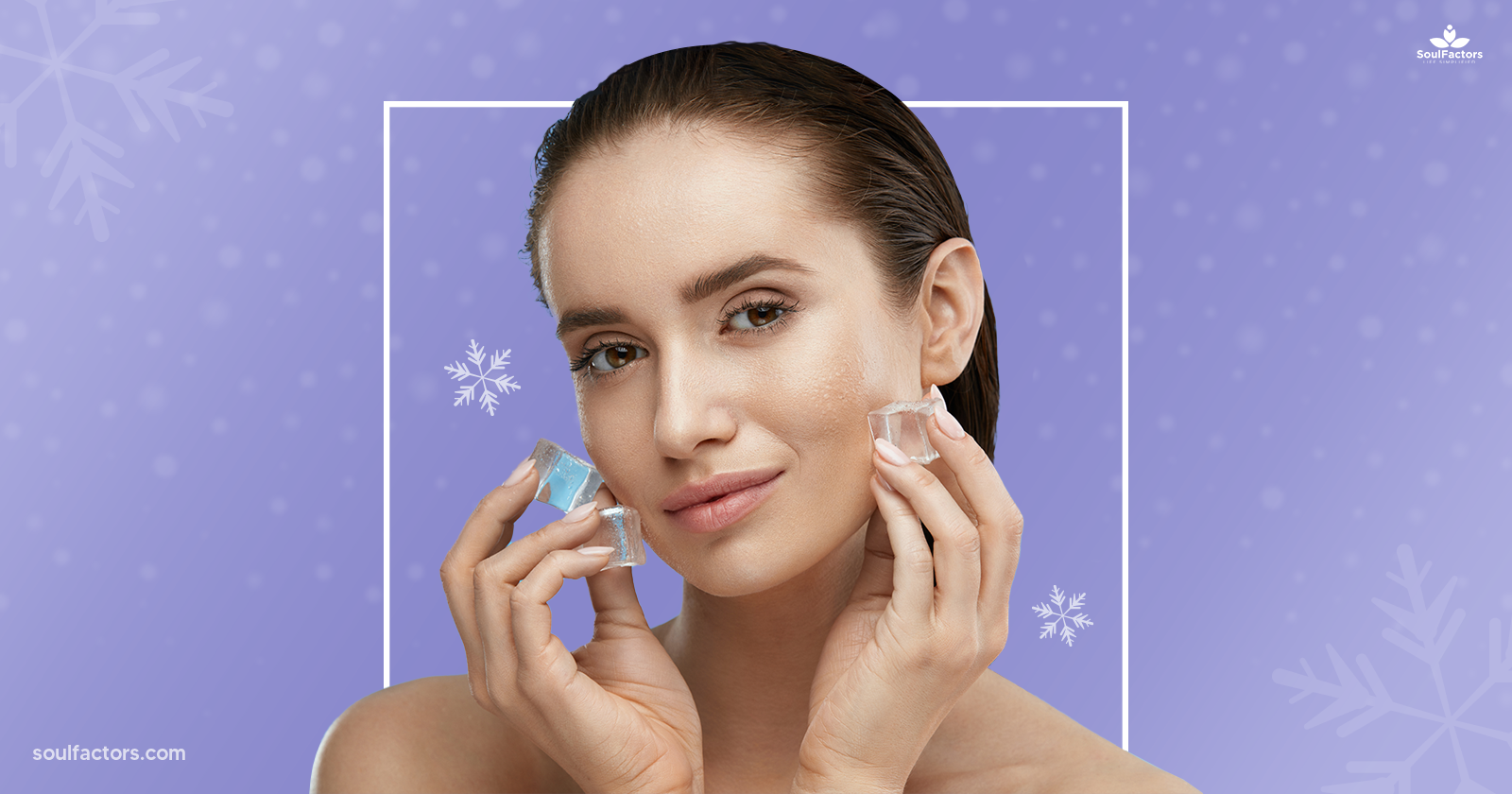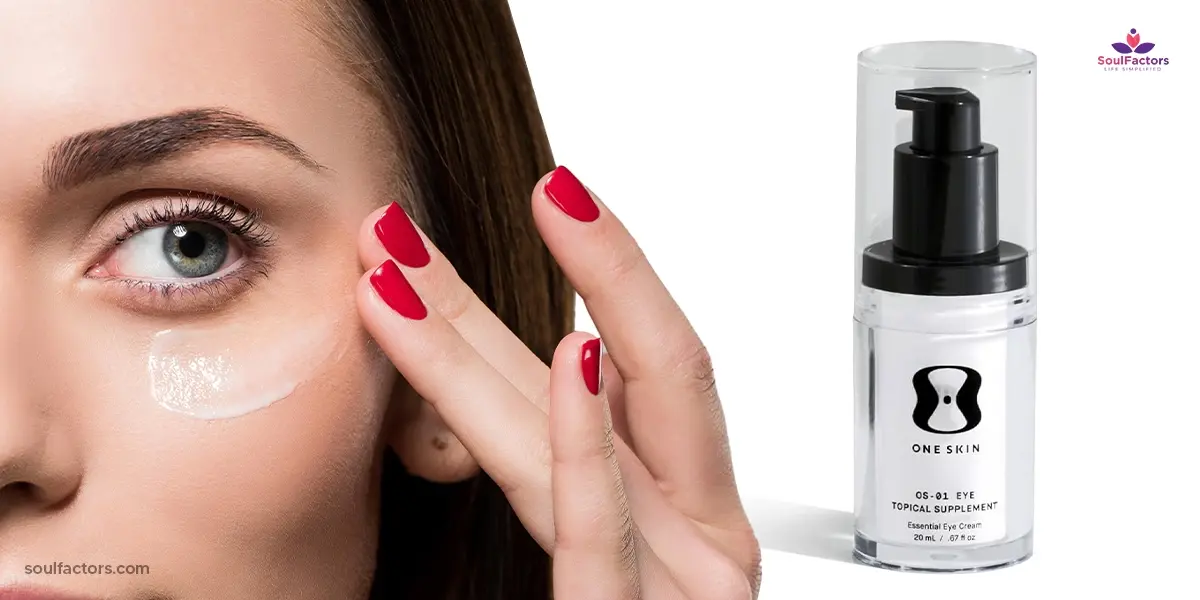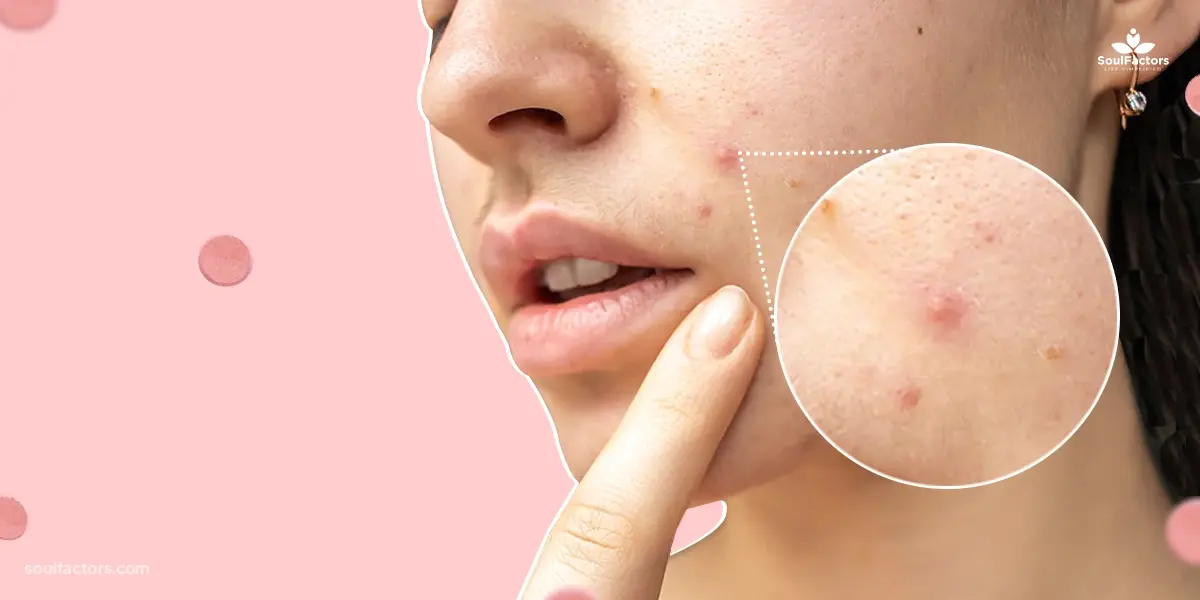Milia Under Your Eyes: Now, What’s That?
Ever had to deal with small white bumps on your face? Milia is an innocuous war on your skin and you can get rid of them.
On Apr 12, 2023 – 12 minutes read

Who knew about those teeny tiny bumps called milia under your eyes? Those usually go by the name milk spots. You may mistake them for acne clusters, skin tags, or even whiteheads.
Still doesn’t ring a bell?
Milia are the tiny, hard, white bumps or cysts under your skin. They can crop up anywhere on the skin, but especially under the eyes. Though they are tiny, they are almost always annoyingly stubborn to leave your skin. But there is good news! There are easy and effective removal methods to get rid of milia! Keep reading!
Milia Under Your Eyes: Causes, Symptoms, And Treatment!
So, what are milia under eyes? And why do they appear on your skin? According to dermatologists, milia are those small white or yellow (or the same color as the person’s skin) cysts that appear on the surface of the skin when dead skin cells become trapped with keratin. As skin cells die off and shed with your pores, keratin may become trapped in the pore, resulting in the formation of a milium. But unlike spots, they don’t form from the pores.

Made up (or more precisely trapped) of keratin —a protein on the outermost layer of the skin, milia may (but not always) appear in clusters resembling whiteheads. You can have one or several at once. At times, that single white pimple you see under your eye may be a milium riding solo.
As you may have tried, you cannot pop milia as you do with pimples and whiteheads on your face. In fact, they might disappear if you apply pressure on them. What makes milia different from whiteheads is that they can be extracted and they don’t need any acne medication for treatment. Even if your skin is not normally prone to inflammatory acne, you can still develop milia under your eyes.
From a health standpoint, milia (or milium for one) is not something you should fret over. They are purely cosmetic issues without any sort of health concerns attached. In simple words, they don’t lead to any additional issues nor do they scar your skin.
Milia In New-born Babies
Generally, in adults, they usually appear around and under the eyes, cheeks, forehead, and genitals. There is no clear reason as to why some people have milia while others don’t. Milia can appear in children and adults but surprisingly, these are commonly associated with newborn babies as well. In fact, nearly half of newborn babies(1) have at least some milia on their tiny faces. For newborns and some adults, milia go away on their own, eventually — sometimes within a matter of a few weeks. But for some, removal of milia may be necessary. Because if you had a choice, you won’t want them on your face, right?

So, if you really want them gone, an expert can perform a quick and easy in-office treatment to remove under-eye milia. When milia are smattered pretty close to the eyes, they may need special care (probably from an ophthalmologist) while treating as to not damage the person’s vision. Before we go deep into how to cure milia under eyes, let’s see the causes and categorization of milia.
What Causes Milia Under Eyes?
We know that, unlike acne, hormones do not play a role in the case of milia. The exact causes of milia are not yet pinpointed.

However, several years of dermatological practices have concluded that different factors contribute to the formation of milia in adults. Based on these factors and causes, milia are categorized into two —primary milia and secondary milia.
Primary Milia
Both primary milia and secondary milia look similar but their reason for formation differs. Your skin may look so healthy that you doubt you’d get any sort of spots on your skin. But, (surprise, surprise!) milia appear on healthy skin, too. When milia occur spontaneously due to thin-walled balls of keratin trapped under the top layers of the skin, they are primary milia. Because the overlying pores have closed, these tiny cysts can take time to resolve on their own. But they are temporary and do leave naturally on their own.
Primary milia are milia under and around your eyes, around your nose, cheeks, forehead, and genitals. Aside from neonatal or congenital milia (the kind babies get), primary milia are common.
Secondary Milia
The second type of milia, secondary milia, can, unfortunately, be permanent. These are also the reason why people want them removed. What causes secondary milia? They occur when something clogs the sweat ducts and as a response to skin damage (which is why they are also called traumatic milia). It could be anything from an infection to some kind of skin trauma to lifestyle factors.
Secondary milia can form when your skin damages in any way, such as:
- Skin damage from rashes, abrasions, burns, or any other injuries
- Within healing blisters and scars
- Chronic sun damage
- Aggressive or irritating skincare products
- Due to rich, occlusive moisturizers
- Excess use of oil-based beauty products
- Skin resurfacing procedures —chemical peels, dermabrasions, ablative laser treatment
- Infection like herpes
- Reaction to medication such as corticosteroids
- Lack of sleep
- Smoking
- Poor personal hygiene
- Long-term use of steroid
Now, let’s get to the bottom of a few of these factors!!
Why is sun damage a risk factor for milia? Skin damage from the sun makes skin rough and leathery. This affects how your dead skin cells are shed. They will find it difficult to rise to the skin’s surface and shed normally, resulting in the formation of milia.
Estheticians state that the reason why you find milia more commonly among people who smoke is that the fumes blow upwards which is basically into the eye area. This can cause keratinization of the skin and form milia as a result. Interestingly, some studies showed they appear within tattoos, too. Also, for some people, genetic disorders(2) cause milia.
To conclude, milia are categorized as primary or secondary. While primary milia include the keratin entrapped cysts, secondary milia include the ones that form after something (such as a burn or injury) clogs the ducts.
Why Does Milia Form Under and Around the Eyes?
Milia are more commonly found around the eyes. Is there any particular reason for that? What causes milia under the eyes? It is unclear but perhaps, it could be because of the skin around the eyes. When using skincare products, we are often told to not go near the eyes, right?
So this results in improper (or lack of) skincare penetration around the eyes. Unlike skin on the rest of the face, the skin around your eyes does not contain oil glands that help keep the skin moist. Also, there is limited blood circulation there. So this thin and delicate area around the eyes does not get properly cleaned or exfoliated.

This is the story of one side. The other side complains about how heavy and harsh creams can cause milia due to the delicate skin around the eyes is. If you think about how much concealers and eye creams can build up, you should take proper care for the skin there. Thus, we can conclude that the eye creams you use there need to be specialized. The cream must have the ability to absorb as well as increase firmness and skin volume.
This brings us to the factor of how using occlusive moisturizers causes milia. Occlusive ingredients are usually believed to be good for the skin, as they work by moisturizing the skin by preventing hydration loss.
But these ingredients also form an additional barrier on top of the existing skin barrier. This can provoke milia to form because of the stopping of the skin’s natural exfoliation. So, if you have milia, try to avoid using creams with ingredients such as mineral oil, lanolin, beeswax or vegetable was, and anything labeled as a balm.
Milia Under the Eyes: Symptoms and Diagnosis
As I have mentioned above, signs and symptoms of milia mainly include the appearance of small, 1-2 mm of raised white or yellow, dome-shaped bumps that are neither painful nor itchy. The different locations for the two types of milia differ from each other.
While primary milia appear around the eyes, cheeks, nose, and forehead, secondary milia appear anywhere on the body where another skin condition exists. Particularly on the faces of people who have a lot of sun exposure. There are the symptoms of milia.

Moving on to the diagnosing part of milia, your regular doctor or dermatologist can easily recognize milia after a visual examination of your skin. After a quick chat about your history, the doctor can figure out whether your milia are a completely random occurrence or not.
Another cause is skin trauma or treatment. If none of these are the reason, there may be some underlying conditions like genetic skin disorders that could further lead to multiple milia.
Treatment For Milia Under the Eyes
If you are not a fan of milia (not everyone is), you have options to get rid of milia for good. Before you consider any treatment for milia, it is important to note that milia may disappear on its own. Admittedly, there have been cases of milia where milia have lasted for several years (even decades in rare cases!).
However, in the case of primary milia, they usually disappear within weeks. Or a few months, depending on the underlying cause. You just have to wait it out. But in any case, they are completely harmless to your health.

So, if they don’t bother you, it is best to leave them be. If they do bother you, I have mentioned possible treatment options you have for treating milia under the eyes, including under-eye milia home remedies.
It goes without saying that you cannot try any of the professional treatments mentioned below at home by yourself. If you don’t remove it in the right way, they may damage your skin. Especially if you have sensitive skin. And may leave a permanent scar.
At-Home Treatment (Or Home Remedies) For Milia Under Eyes
Though these treatments are recommended to try at home, it is better to talk to your dermatologist first. Depending on how sensitive your skin is, your dermatologist will help you choose the best treatment option for you. Because, hello, you know how delicate the skin around your eyes is. So, treat your milia under the eyes at home using these milia removal products.
Gentle Exfoliation
First, you can try adding gentle exfoliation treatment to your skincare routine. Of course, you don’t have to—and shouldn’t—do it every day. Milia often forms on dry and under-exfoliated skin.
When you allow the old layers of dead skin cells trapped to shed from the surface of your skin, you can get rid of them altogether and prevent them from being trapped again. With less (or no) build-up, it also allows moisturizers and other eye creams to penetrate the skin further.

You can choose any gentle chemical exfoliating products instead of physical exfoliants. The best product to start off with is an OTC salicylic acid or glycolic acid product.
But since milia are stubborn, you have to be patient to get your desired result. It may take months to see any improvement. Also, be careful when you add these products into your routine, you have to go slow with them.
Chemical Peels
The next option is chemical peels. These superficial peels also help you exfoliate your skin without having to aggressively scrub your already delicate skin. OTC chemical peels usually contain salicylic acid(3), lactic acid, or glycolic acid.

These ingredients help in providing non-abrasive, accelerated chemical exfoliation to lift the top layer of skin. However, though some studies show that though these are highly recommended almost all the time —especially before a professional treatment, these are unlikely to remove milia under eyes. But worth a shot, right?
Topical Retinoid
This is another highly recommended treatment option you can add to your skincare routine. More than a treatment, it is an effective prevention option of milia formation. Retinoids encourage skin cellular turnover, help unclog any build-ups on the skin, reduce the “stickiness” of cells in your pores.

At home, you can rub a washcloth on your skin gently to help loosen it followed by applying retinoid. This combination of physical, as well as chemical exfoliation, helps bring old trapped cells to the surface of the skin while reducing the appearance of milia. Retinoids are normally used as milia under eye creams.
Manuka Honey
For a natural solution, you can use manuka honey(4) mask on your face. Due to its antimicrobial properties, it can reduce the inflammation that can sometimes lead to milia. This too is more of a preventive option.

Professional Medical Treatments for Milia Under Eyes
If all of the above options fail, and you want to get rid of milia sooner rather than later, you can go for professional treatments for milia under your eyes. All of these must be done by a professional. So, do not try any of these options at home.
In-office Extraction
A licensed dermatologist can easily remove milia using a tiny needle to open the pore and draw the keratin out from under the skin. Sometimes called deroofing, this careful extraction leaves an incision in the skin. The princess is painless and the results are immediate.

Laster Ablation
This treatment is similar to extraction, except with lasers. A small laser focuses on the milia to open the keratin-trapped cysts and draw the keratin build-up from underneath the skin. If you are not a fan of lasers, choose a different option!

Cryotherapy
In some cases, cryotherapy may be a good option but not always. Because the skin is so sensitive and delicate that it may not always be the best solution.

The doctors use liquid nitrogen to freeze milia, effectively destroying them. But this procedure may even cause scarring and pigmentation changes. So, choose it at your own risk, after talking to your derm about treatment options.
Electrodesiccation
This process sounds intimidating but it is not as terrifying. It uses a current device to cauterize and destroy milia by heating the skin around them. But it is done under a local anesthetic cream to minimize any possible twinges.

These are the treatment options to cure milia under the eyes. Professional treatments are of course more effective and the results will be immediate than at-home treatments. But like I have mentioned, if milia don’t bother you, let them alone!
Using Makeup on Milia
Some women ask whether they can apply makeup on top of milia to cover them up. Covering milia with heavy layers of makeup will further clog your pores, preventing the natural process of shedding skin cells and trapping keratin beneath your skin. Also, you may end up with uneven texture because of the bumps.

So, if you are applying makeup, choose hypoallergenic products that won’t clog your pores and apply a light layer of power-based makeup (especially under your eyes) to cover them up. All things considered, it is extremely important to remove all makeup every day.
Final Thoughts
Milia are bothersome purely for aesthetic reasons. But if you want those harmless cysts removed, you have treatment options. To prevent milia under your eyes from forming, always use lightweight eye cream formula that quickly absorbs without blocking your pores and wear sun protection to not let the UV rays harm your skin around the eyes. If you take care of your skin like it needs to be, you can avoid getting these tiny bumps.

Subscribe to Newsletter
Elevate your routine, stay on trend, and embrace a personalized beauty journey with our curated insights.





Write a Comment